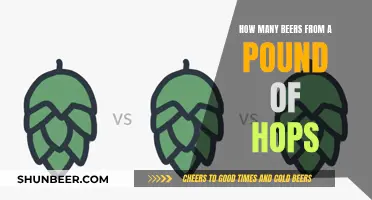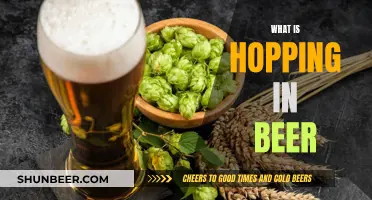
Homebrewers often ask how many hops they need for a 5-gallon batch of beer. The answer depends on the type of beer being brewed and the desired level of bitterness, flavour, and aroma. For example, a highly hopped beer like an IPA or APA will require a larger quantity of hops than a maltier beer such as a lager or wheat beer. The range of hops used in a 5-gallon batch can vary from 0.75 oz to 8 oz or even more, depending on the recipe and style of beer.
| Characteristics | Values |
|---|---|
| Hops for 5 gallons of beer | 100-250 grams (3.5oz-9oz) |
| Hazy DIPA | 4 oz whirlpool, 4 oz dry hop at high krausen, 4 oz dry hop 2 days before cold crash |
| Pale Ale | 20-30 IBU at 60 min, 2-3 oz late hops, 2 oz dry hops |
| IPA | 40 IBU at 60 min, 4-5 oz late hops, 4 oz dry hops |
| NEIPA | 0-20 IBU at 60 min, 6-8 oz late hops, 6 oz dry hops |
What You'll Learn
- Hazy IPAs: 4 oz whirlpool, 4 oz dry hop at high krausen, 4 oz dry hop before cold crash
- Pale ales: 20-30 IBU, 2-3 oz late hops, 2 oz dry hops
- IPAs: 40 IBU, 4-5 oz late hops, 4 oz dry hops
- NEIPAs: 0-20 IBU, 6-8 oz late hops, 6 oz dry hops
- Dry hopping: 0.5-1.5 oz for pale ales, 1.5-2.5 oz for IPAs, 2-5 oz for dIPAs

Hazy IPAs: 4 oz whirlpool, 4 oz dry hop at high krausen, 4 oz dry hop before cold crash
Hazy IPAs are heavily dry-hopped beers, and the amount of hops used can vary depending on the desired intensity of the hop flavour and aroma. A standard dry-hopped beer will typically use 2-3 ounces of hops per 5 gallons, but for a hazy IPA, you can use anywhere from 4 to 16 ounces or even more for a hazy DIPA.
When dry hopping a hazy IPA, it is common to do multiple dry hop charges at different stages of the brewing process. One popular method is to do a 4 oz whirlpool addition, followed by a 4 oz dry hop addition at high krausen, and finally another 4 oz dry hop addition a few days before cold crashing. This three-stage dry hopping process helps to maximise the hop flavour and aroma in the final beer.
The first dry hop addition at the whirlpool stage adds hop flavour and aroma without contributing much bitterness to the beer. The second dry hop addition at high krausen is believed to unlock the full potential of hop oils through a process called biotransformation, which enhances the flavours and aromas of the finished beer. The third dry hop addition just before cold crashing helps to freshen up the aroma of the beer.
It is important to note that dry hopping too heavily or for too long can lead to some negative side effects, such as vegetal taste, oxidation, and hop creep. However, with proper sanitisation techniques and careful timing of the dry hop additions, these issues can be minimised.
How NA Beer is Brewed Without Hops
You may want to see also

Pale ales: 20-30 IBU, 2-3 oz late hops, 2 oz dry hops
Brewing 5 gallons of pale ale with 20-30 IBUs involves adding 2-3 oz of late hops and 2 oz of dry hops. This hop schedule can be adjusted to personal preference, but it is a good starting point for brewing a pale ale with moderate bitterness and a prominent hop presence.
Late hops are typically added during the last 15 minutes of the boil, while dry hops are added directly to the fermenter after the boil. The type of hops used will also affect the flavour and aroma of the beer. Some popular choices for pale ales include Cascade, Centennial, Chinook, Columbus, Amarillo, Simcoe, Warrior, and Palisade.
When brewing a pale ale, it is important to consider the balance between the hops and the malt profile. Too many late hops or dry hops can overwhelm the malt character, while too few may result in a dull beer. Finding the right balance between the hops and malt will allow the desired flavours and aromas to shine through.
Additionally, the bitterness of the beer can be adjusted by changing the amount of bittering hops added early in the boil. For a more bitter pale ale, increase the amount of early hops, and for a less bitter beer, reduce the amount. The brewing process, such as the length of the boil and the type of yeast used, will also affect the final product.
By experimenting with different hop varieties, schedules, and techniques, brewers can create pale ales that suit their personal tastes and preferences.
Gose Beer and Hops: An Unlikely Friendship
You may want to see also

IPAs: 40 IBU, 4-5 oz late hops, 4 oz dry hops
The amount of hops required for a 5-gallon batch of beer depends on the style of beer and the desired level of bitterness, flavour, and aroma. For example, a hazy IPA will require a different amount of hops than a pale ale or a lager.
When it comes to IPAs, the amount of hops used can vary depending on the specific recipe and the desired level of bitterness, flavour, and aroma. However, as a general guideline, for a 5-gallon batch of IPA, you would typically use:
- 40 IBUs of bittering hops, added early in the boil
- 4-5 oz of late hops, added during the last 15 minutes of the boil or at knockout
- 1.5-2.5 oz of dry hops, added after fermentation
The bittering hops provide the majority of the bitterness in the beer, while the late hops and dry hops contribute to the flavour and aroma. The specific amount of hops within this range that you use can depend on your personal preference and the desired balance of bitterness, flavour, and aroma in your IPA.
It's important to note that these are general guidelines, and different recipes and brewers may use different amounts of hops to achieve their desired flavour profiles. Additionally, other factors such as the type of hops, the alpha acid levels, and the timing of the hop additions can also impact the final beer.
Icehouse Beer: Hops or No Hops?
You may want to see also

NEIPAs: 0-20 IBU, 6-8 oz late hops, 6 oz dry hops
The amount of hops required for a 5-gallon batch of beer depends on the style of beer being brewed. For example, a homebrewer might use 1 oz of hops to make 5 gallons of a cream ale or Belgian beer, whereas an IPA might require 8 oz of hops for the same batch size.
For a New England IPA (NEIPA), the hopping schedule will look something like this:
> NEIPA: 0-20 IBU at 60 min; 6-8 oz late hops; 6 oz dry hops
This means that for a NEIPA, the hops are added at three different stages of the brewing process:
- First, hops are added at the beginning of the boil for bittering. For a NEIPA, the target is to achieve 0-20 International Bittering Units (IBUs).
- Next, "late hops" are added after the initial boil, anytime between 15 minutes and the end of the boil. For a NEIPA, 6-8 oz of late hops are added.
- Finally, "dry hops" are added after the boil, during fermentation. For a NEIPA, an additional 6 oz of hops are added at this stage.
The amount of hops added at each stage, as well as the timing of the additions, will vary depending on the desired flavour profile and bitterness level of the final beer.
Exploring Mexican-Style Beer: A Hoppy Adventure
You may want to see also

Dry hopping: 0.5-1.5 oz for pale ales, 1.5-2.5 oz for IPAs, 2-5 oz for dIPAs
When dry hopping 5 gallons of beer, the amount of hops you'll need depends on the style of beer you're making. For pale ales, you'll need between 0.5 and 1.5 ounces of hops. For IPAs, you'll need between 1.5 and 2.5 ounces, and for double IPAs (dIPAs), you'll need between 2 and 5 ounces. These amounts can be adjusted to your personal taste preferences, and you can always add more hops if needed.
When dry hopping, it's important to use fresh, green hops to get the best aroma. The contact time between the hops and the beer can vary from as little as 3 days to as long as you keep the beer in the keg. However, longer contact times may impart a grassy flavour to the beer.
The type of hops you use will also depend on the specific style of beer you're brewing. For American pale ales, citrusy, American-style hops are typically used, such as Cascade, Centennial, Chinook, or Columbus. Newer varieties like Amarillo, Simcoe, Warrior, and Palisade are also popular. You can experiment with different hop varieties to find the ones that work best for your beer.
In addition to dry hopping, you can also add hops at different stages of the brewing process, such as early in the boil for bittering, or towards the end of the boil for flavour and aroma. The amount of hops added at each stage will depend on the desired intensity of hop flavour and aroma in the final beer.
When brewing 5 gallons of beer, it's important to consider the overall balance of the ingredients. While hops are crucial, especially in hop-forward styles like IPAs, too many hops can overwhelm the malt profile. Finding the right balance between hops and malt will result in a more harmonious beer.
The Hoppy Truth: Do All Beers Have Hops?
You may want to see also
Frequently asked questions
It depends on the type of beer you are making. For a hazy DIPA, you may need up to 12oz of hops. For an American pale ale, 0.5-1.5oz of hops should be enough. For an IPA, you will need 1.5-2.5oz of hops, and for a DIPA, 2-5oz.
The price of hops can vary depending on the type and quantity purchased. For example, 250 grams of Citra hops cost $38.50.
The style of beer, desired bitterness, and alpha acid levels all influence the amount of hops needed.
Hops can be added at different times, such as early in the boil for bittering, with 15 minutes left for flavor, or in the last 5 minutes for aroma. Dry hopping is also an option.
Yes, you can grow your own hops. However, it is important to note that the availability and cost of hops may vary depending on your location.







